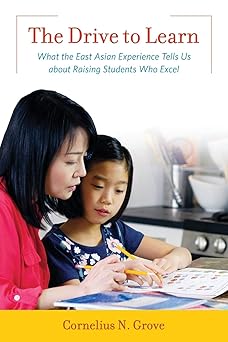
The Drive to Lea:What the East Asian Experience Tells Us about Raising Students Who Excel
by: Coelius N. Grove Ed.D. independent scholar author of "The Aptitude Myth" (2013) (Author)
Publisher: Rowman & Littlefield Publishers
Publication Date: 2017/6/5
Language: English
Print Length: 182 pages
ISBN-10: 1475815107
ISBN-13: 9781475815108
Book Description
Countless books and articles have offered remedies for the poor leaing outcomes of American schoolchildren. Virtually all of these publications share one thing in common:They propose improvements in the policies and practices controlled by adult educators. Grove believes that our children’s poor leaing cannot be totally the fault of educators. Our children are active participants in classrooms, so if there’s a problem with how well our children are leaing, then we as parents might be at fault. To discover what our part is and explore what can be done about it, Grove draws on over 100 anthropological studies of children’s leaing and child-rearing in China, Japan, and Korea. They reveal that those children, even the youngest ones, are highly receptive to classroom leaing. Why do they come into classrooms with attentive and engaged attitudes? How did they acquire the drive to lea? Can American parents benefit from knowing how Chinese, Japanese, and Korean parents think about and carry out child-rearing? The Drive to Lea explores these questions.
About the Author
Countless books and articles have offered remedies for the poor leaing outcomes of American schoolchildren. Virtually all of these publications share one thing in common:They propose improvements in the policies and practices controlled by adult educators. Grove believes that our children’s poor leaing cannot be totally the fault of educators. Our children are active participants in classrooms, so if there’s a problem with how well our children are leaing, then we as parents might be at fault. To discover what our part is and explore what can be done about it, Grove draws on over 100 anthropological studies of children’s leaing and child-rearing in China, Japan, and Korea. They reveal that those children, even the youngest ones, are highly receptive to classroom leaing. Why do they come into classrooms with attentive and engaged attitudes? How did they acquire the drive to lea? Can American parents benefit from knowing how Chinese, Japanese, and Korean parents think about and carry out child-rearing? The Drive to Lea explores these questions.
 Wow! eBook
Wow! eBook

